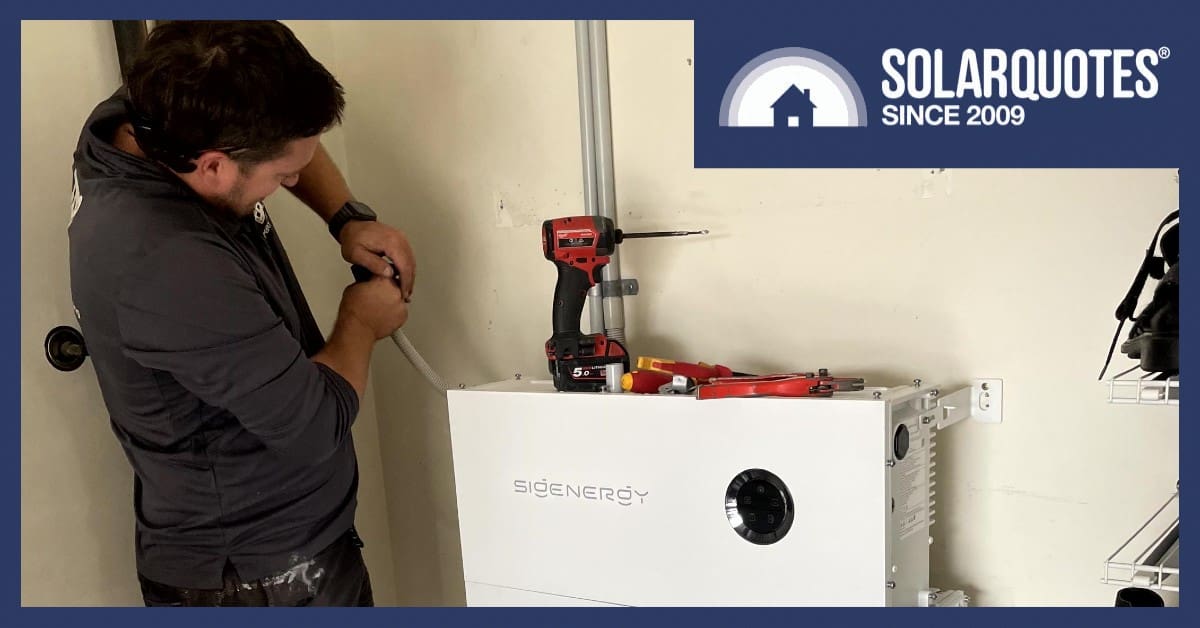
Demand for the federal battery rebate is so intense that many installers are fully booked for months and struggling to find battery stock, with some jobs already being pushed into next year when the incentive drops in value.
How Long Is The Wait List For Battery Installs?
With tens of thousands of Australians taking advantage of the Cheaper Home Batteries Program, fully-booked installers across the country aren’t able to fit in new jobs for months. Installers are short not just on time but also on stock, as they compete for dwindling supplies of popular solar battery brands.
Installers Booked Out For Months
Multiple battery installers interviewed by SolarQuotes say that customers who book an install now can expect a wait of two-to-four months.
Tim Sturgiss of Huglo Solar, who does installs in NSW & the ACT, says there has been “huge interest” and he is already booked out to late October.
“We’re already looking to book into November, we don’t like being too much further out as that becomes a horrible customer experience. I suspect we’ll be booked out for the year by the end of September,” he tells SolarQuotes.
Rob Moffa, who is in regular contact with installers in his client operations role at SolarQuotes, says he’s hearing about similar wait periods for home battery installs across the country.
“Historical trends will tell you there’s plenty of time to book in an install to get it done before Christmas. But this year if you wait until October, November, and you’re wanting it by Christmas, its just not going to happen. If you don’t act now, you’re more than likely going to miss out this year,” he says.
Rob warns that installers are so flat-out that many will likely want to take a decent break towards the end of the year.
“When the industry hasn’t been that busy, just plodding along nicely, installers may work through Christmas. But I think we’ll see an uptake of installers breaking through Christmas, exhausted and needing to recharge,” he says.
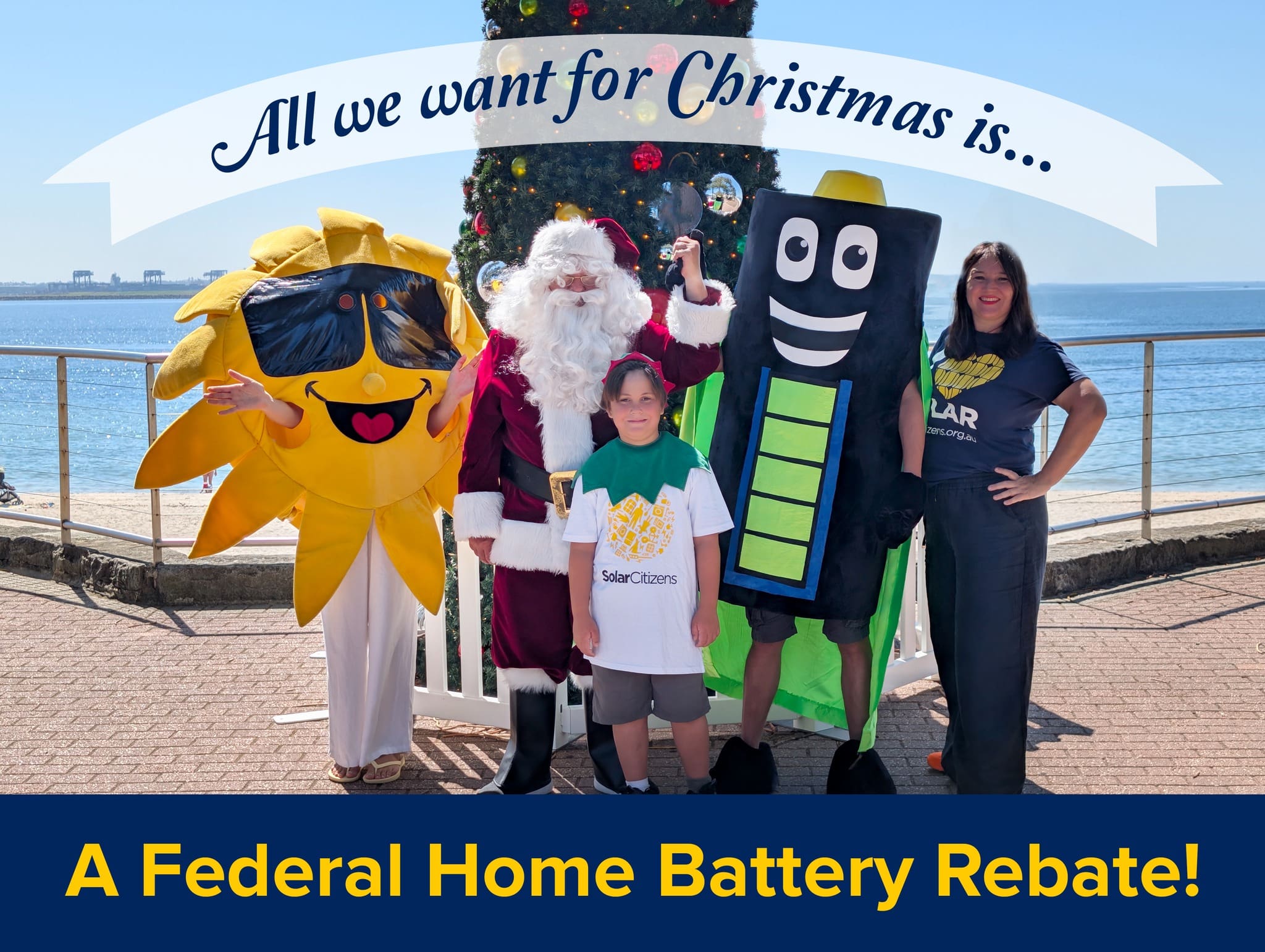
Last Christmas Solar Citizens campaigned for a federal battery rebate, and with that now in place installers will likely take a well-earned break this festive season.
Installs Pushed To 2026 With Reduced Battery Rebate
One issue with not getting an install done by the end of the year is that the federal battery rebate will drop in value in 2026. While it is a smaller drop than the amount the solar rebate falls each year, it does mean that homeowners who see the prices advertised now might end up with a slightly higher quote than they expected.
Sturgiss warned homeowners should be on guard for “misinformation” and be aware that the rebate applies to the date of the actual install, not when the quote is signed off on.
He argues though that it is better to risk a slightly reduced rebate rather than get a cowboy installer to do the work.
“Yes your rebate might go down, but if you rush it through with some installer who is not qualified, it is going to cost you more in the long run,” he says.
Rob meanwhile warns that installers should also be conscious of the approach of the end of the year, as they are obliged to honour prices agreed with customers, which could leave them out of pocket should the rebate be less than they budgeted for.
“If the install date is scheduled for next year, the final price needs to be based on that installation date. I’ve seen in past, installers provide quotes thinking it will happen before Christmas, but they don’t get it done in time, and are out of pocket,” he says.
Some installers are already so booked up that new customers will have to wait until next year, such as with Robby Mack of Energy SA.
“We’re already booking January at the moment – the customers are in a queue with us for install, while we’re in a queue with wholesalers for batteries. There’s been continual delays in stock which is a huge challenge, if you have all these bookings and then there’s container delays,” Mack tells SolarQuotes.
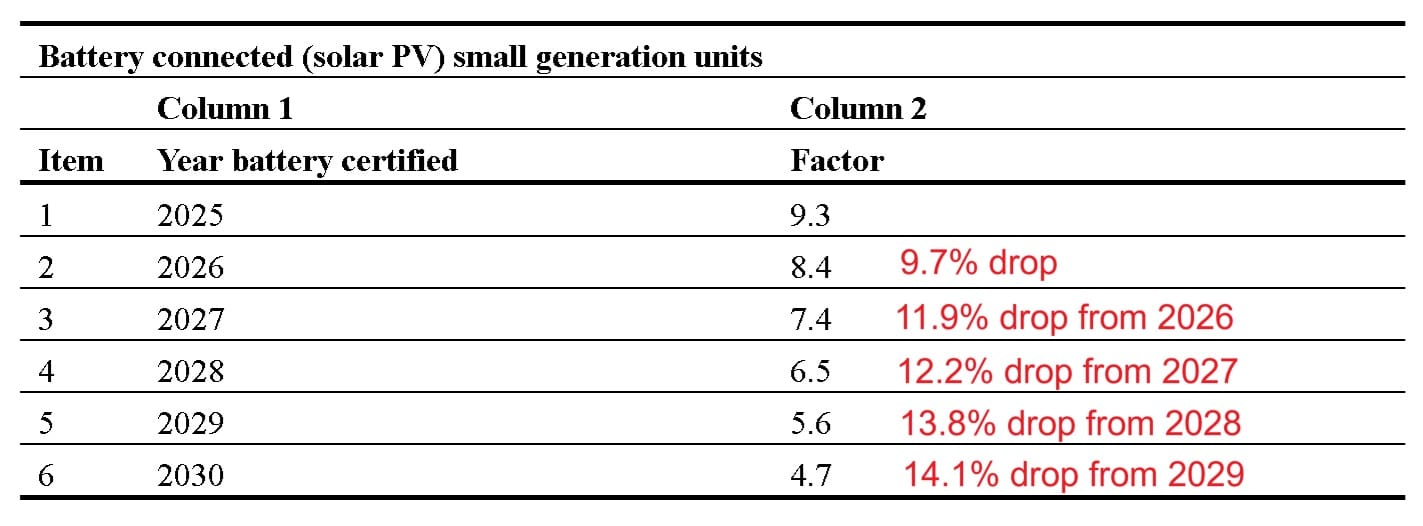
The federal battery rebate declines each year, although at a slower speed than the solar rebate.
Solar Battery Brands Facing Stock Shortages
Some popular brands have been short on supply amid the rebate mania. Installers singled out Sigenergy as particularly tricky to source at times, along with Goodwe, BYD and Sungrow. Even bollards to protect batteries have been in short supply.
Tesla and Enphase conversely are two brands that installers have found easier to procure through this period.
Abhinu Raghavan of WA-based installer Fritts Solar tells SolarQuotes he is currently booking customers for three months from now, and expects his bookings to be pushed into 2026 by the end of September.
Raghavan claims he ordered 800 units of BYD batteries earlier in the year, but only got 27 delivered in July, and expects just 75 next month.
One option to avoid battery shortages is to book a solar-only install, which has the added benefit of allowing a new solar owner to get a grasp on consumption patterns to better inform the correct choice of battery size.
Raghavan cautions however that some installers are reluctant to take solar-only installs at the moment because rebate rules constrain how many jobs they can sign off on per day, so are finding it more efficient to do solar-and-battery installs.
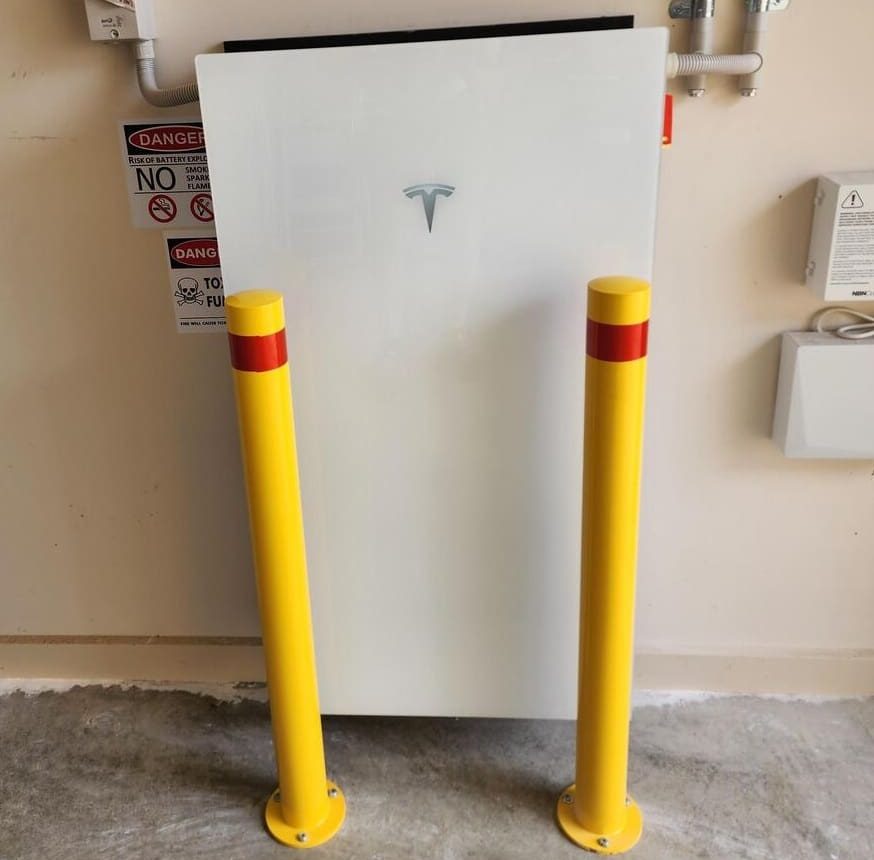
In a market where even bollards are in short supply, apparently Tesla Powerwall 3s are still readily available – thanks perhaps to the inflammatory behaviour of a certain CEO.
Could A Backup Brand Shorten The Wait?
Raghavan suggests customers could potentially reduce the amount of time they wait by getting multiple quotes from different installers, and having an alternative quality brand in mind.
“Some salespeople will be telling customers they can install in 4-5 weeks, but in reality it might be longer. Especially in this time with supply shortages, rather than having one preferred brand, customers can have at least an alternative option, so if there is not supply of one brand, they can get another, then they can get it installed this year,” he says.
Other installers aren’t so sure, including Mack at Energy SA.
“Customers are sold on the features, so its not something we’d try and slip them on a different brand, they’ve chosen a particular brand on features and price. It is not like a solar panel where the differences between brands are minimal: there are pretty big differences in batteries in costs and features, so it is often not practical to change brand,” he says.
Sturgiss at Huglo Solar is on a similar page.
“There’s too much dog’s crap out there,” Sturgiss says. “I don’t like going wide on brands.”
For more on batteries and to research brands, consult the SolarQuotes battery comparison table. For more on the federal battery rebate, read our detailed guide.

 RSS - Posts
RSS - Posts


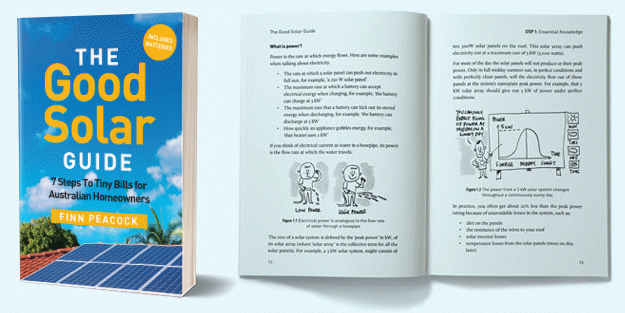
Colour me shocked.
I did wonder if the 2 per day limit was a little restrictive. The solar and hardware for the battery can be done by someone other than a CEC certified electrician.
With the initial design, final wiring and sign off done by the electrician.
The limit for the number of jobs to be signed off per day for a CEC approved electrician, is in place to hopefully reduce the Workcover claims due to over work and mistakes due to fatigue. It is also there to protect the consumer against poor workmanship ,sub-standard designs, cheap, nasty equipment and hopefully reduce and week out the rip-off merchant’s as a result (Wishful thinking).
i had an installation done by “Advantage Solar last month, and so far they have not got back to me to come out and fix it. Sloppy cable run, poor mounting of inverter/battery to brick wall with 50% of the unit’s mounting points in mortar. No instructions given before they left, system energized before inspection. Poor design due to shading issues on panels.
It seems anytime a Government starts throwing money around, checks and balances go out the door. The “Fly -by- Nighter’s have emerged from their slumber and at it again./ The CEC should crack down now!
They temporarily increased the limit at the start of the rebate.
I’ve already been told 2026 install by my electrician. Tempted to maybe now hold out to see if the rush dying down effects battery prices from the wholesalers. Seems like they are getting quite inflated at the moment.
Agree. The CEC certified electrician is really only needed for the design and hook up to the meter box then inspection/testing of the installation.
With trained crew setting up the devices as per the plan the electrician could do several nearby installs in a day.
Yep I’ve been waiting since May and each month it gets delayed by another month due to stock shortage.
Which brand?
Back when I checked with my solar installer about a battery option they clearly stated that it wasn’t worth doing if your sole concern was the economics, as was the case for most people. I doubt things have changed this week!
Different households will have different figures for their ROI, and folk are clearly free to do as they like, but nobody I know is bothering – the maths simply doesn’t work. My figures show about 15 years to repay the investment. With a 10 year warranty that isn’t a good deal, especially when interest rates were high. If power prices increase 50% or so, and current battery prices with subsidy remain – which isn’t happening, then the maths might work, at least for me. If battery prices stay static, the subsidy evaporates, and then prices rise, well the maths probably still won’t work, but I’m a low kWh user with a large solar system.
Compounding this my inverter is good, but not battery compatible, so replacing it is both a waste, and a cost. Obviously YMMV.
I have just added a battery to my solar. Cost $8,000 after the subsidy for 14kWh of usable storage.
So far it has been running right down overnight so that is 14Kw at 28 cents per kWh I have not had to purchase from Ergon. That equates to a saving of just over $3 a night or just over $1,000 a year so the battery will pay for itself within eight years.
So I come out ahead financially although maybe not by a huge amount. We do however get some blackout protection from the battery plus if it is day time the solar will keep producing during a grid outage both charging the battery and/or running the house.
I don’t recall the exact specs or figures David but I’m pretty sure when I checked it was about $12,000 for something closer to the 10 kWh size. I think that included installation, but I don’t think it included a battery compatible inverter.
My usual consumption is closer to half yours, though I’d want a similar size battery simply to cover shrinkage over the decade plus periods of higher use e.g. high cloud days – this extends the payback period making it less affordable.
Since I’d only be saving about 22c/kWh, that’d only be about $1.50/day. Oh I’d save the $800 spent on power each year, but I’d lose oh $250 or so in FiTs. Yes the savings are better than the FiTs, but savings are offset by the FiT loss and my real savings are simply too small.
John Alba – “Oh I’d save the $800 spent on power each year, but I’d lose oh $250 or so in FiTs. Yes the savings are better than the FiTs, but savings are offset by the FiT loss” – how long do you really think that the Feed In Tariffs are going to last? They could all be gone within six months. In case you are not aware, the Feed In Tariffs are on the way out, like the subsidising of the tobacco farmers, also expired. And, I understand that some electricity retailers are looking at charging fees for exporting to grids. To me, the purpose of batteries, is to maximise self-consumption, where as much as possible, of electricity generated by the household, is consumed by the household that generated it, to end the penalties for generating electricity from household rooftop photovoltaic systems. That, and, providing, as much as possible, a UPS, for the whole of the household, so that, when the grid supply fails, the household is protected. I never set out to make profit from a PV system.
$8,000.00 for 14Kw of storage ehh ?
With three air conditioning units, two refrigerators, two large chest freezers, three small camping refrigerators running + numerous other household items, I burn a lot of power.
I haven’t gotten around to my 30,000 litre heated swimming pool equipped with a 25Kw inverter heat pump and filtration system yet. That alone draws a constant 8Kw flat chat.
So, to summarise, between midnight and 6am, I consume 50Kwh !
The household average total demand is around 100 Kwh per day. I have 15.35 Kw of panels and a 10Kw Solar Edge inverter.
I could flatten that 14 Kwh battery in around 45 minutes I have worked out. Provided that it hasn’t caught fire or exploded beforehand.
I rest my case.
Hi David,
I’m curious to see the napkin you worked that out on. 50kWh over 6 hours is 8.33kW, or 36amps continuous load at 230Vac. A 14kWh battery would last about 1hr 40 minutes at that rate.
Conversely you’d be running 18.6kW for 45minutes to consume 14kWh. Of course a single phase solar edge battery isn’t going to supply 80amps at 230Vac, but even with 3 x 26Amps, that’s over 40% of your average 3 phase grid connection capacity.
I could drive into the CBD in about 10 minutes I have worked out, but they’d lock me up for speeding so I don’t think the calculation is useful, a bit like the donkeys who bray about grid scale batteries only lasting 5 minutes, it’s missing the point of an integrated system.
The answer is always to try and burn less, and if you can’t do that, move your swimming pool loads to the daytime and install more solar to meet them head on. 25kW would be a good start.
Profligate waste is expensive for everyone, it’s something we can’t afford on a finite planet.
Are you really paying 28c per kWh for overnight power? That seems rather high? Do you not lose FIT to charge the battery during the day?
Even with your numbers and the unlikely event of using all 14kWh each night and being able to fully charge the battery from solar each day (it never rains where you live?) it would still take 8.4 years to pay back the $8k assuming a 6% cost of capital
.28x14x365 – 480=$950.8/year
In regional Queensland where Ergon has a monopoly they don’t offer a range of price deals. I get two rates general and off peak which the HW system uses.
So far the 14Kw available has all been used overnight hitting it’s 90% maximum discharge anywhere from midnight to 7am. Also so far the battery has fully recharged by around midday each day. Weather has been a mix of sunny and showery days but no really wet ones since the battery was installed. I doubt it will fully recharge on a really wet day.
I made some allowance for that in my estimate by calculating only 300 full charges and discharges a year.
Using 300 days, payback blows out to 11.5 years, so whether it returns its capital before the warranty expires will come down to a race between battery degradation and electricity price increases
Look since we are nitpicking every figure the FIT here is fixed at 8c Kw/hr. So factor that figure into any calculations.
Also the $8000 cost included a hybrid inverter and installation, so I suppose that should be factored out to get an actual battery cost. I don’t know how to do that but the installer told me he figured the batteries comprised about half the total cost of my installation with the inverter, labour and profit accounting for most of the other half.
Run your calculations on that and see what you get.
John that was true until recently, but with the introduction of the federal rebate payback periods are now within the warranty period for most, but not all, households.
Perhaps, one thing that could have eased (and, could still ease) the problems caused by the massive increase in demand for the battery systems, would be if the federal government had applied, and, would apply, the SRES assistance that applies to stationary batteries, to mobile batteries; applying it equally to BEV motor vehicles (and, not the “hybrid” scam vehicles), that have V2L with capacity of at least 3.6kW, and/or V2H functionality.
Something to consider…
Another effect of the rush on batteries is the extreme difficulty being experienced by many customers in getting installers to deal with warranty issues.
Tesla has demanded that I not deal direct with them with my issues and get a Tesla certified installer to visit site and liaise directly with Tesla. Sales guy who sold me the system is useless and his contractor is not really obliged to assist but has been doing what he can but he’s flat out with new battery installs. When I did finally get an installer to visit site..he spent an hour waiting for Tesla to answer on their tech support line and gave up.
David V you are certainly in the unique position of being one of the highest domestic electricity consumers in Australia, possibly the world.
Your circumstances have no relevance to the other 99.9% of us.
Consumption at your level would require a three phase grid connection maybe even your own transformer.
But you could install 50Kw of panels and a 50Kw subsidised battery to meet your extreme needs.
I’m hearing from solar installers that they are having a hard time finding workers willing to install panels. Everyone wants to do battery installs and they all want $1500/day.